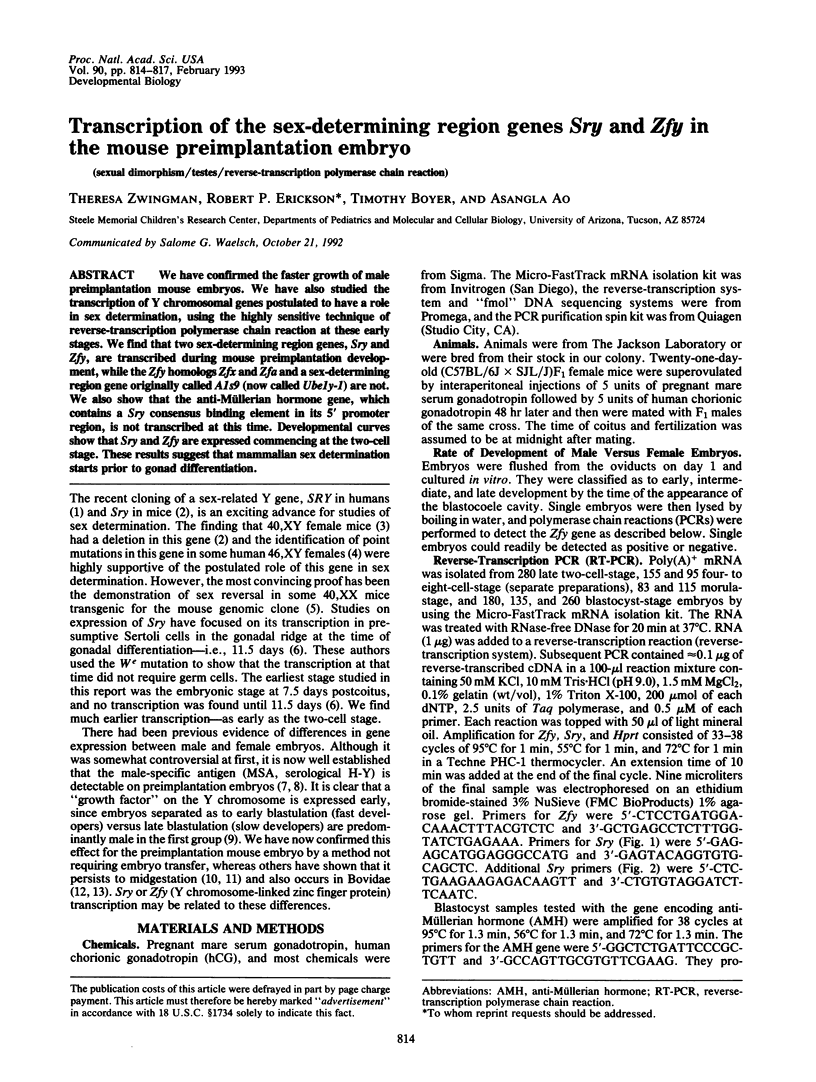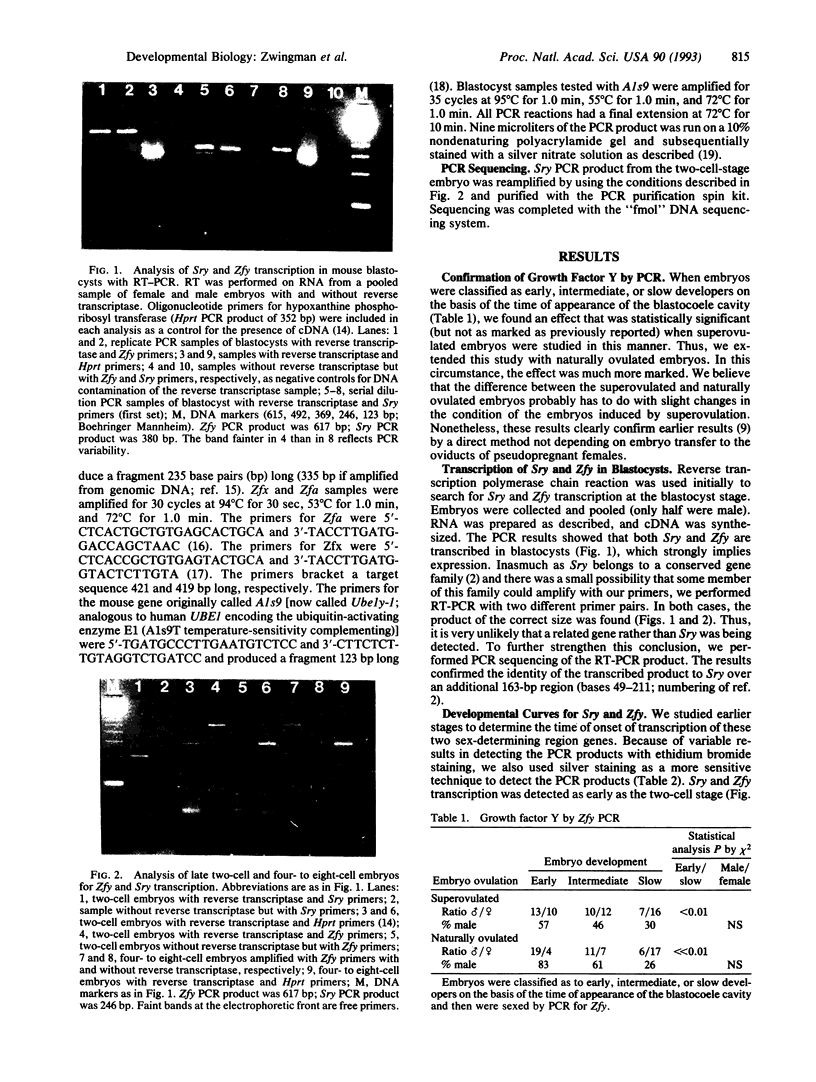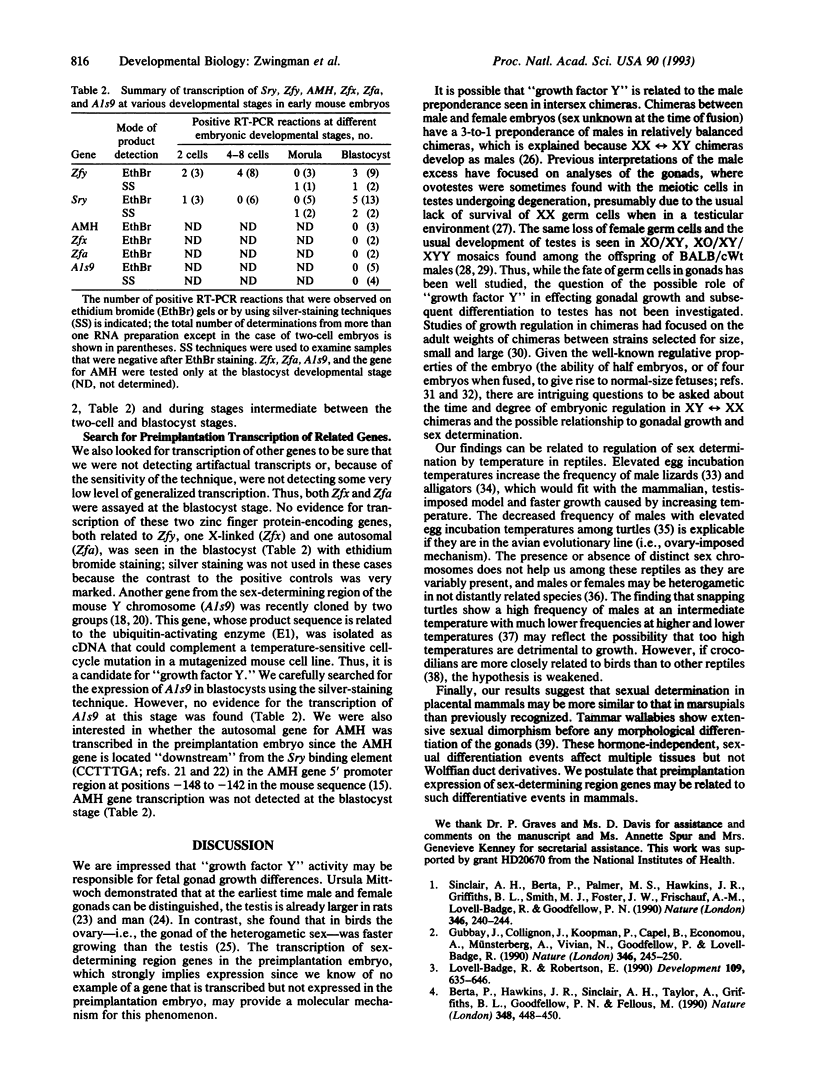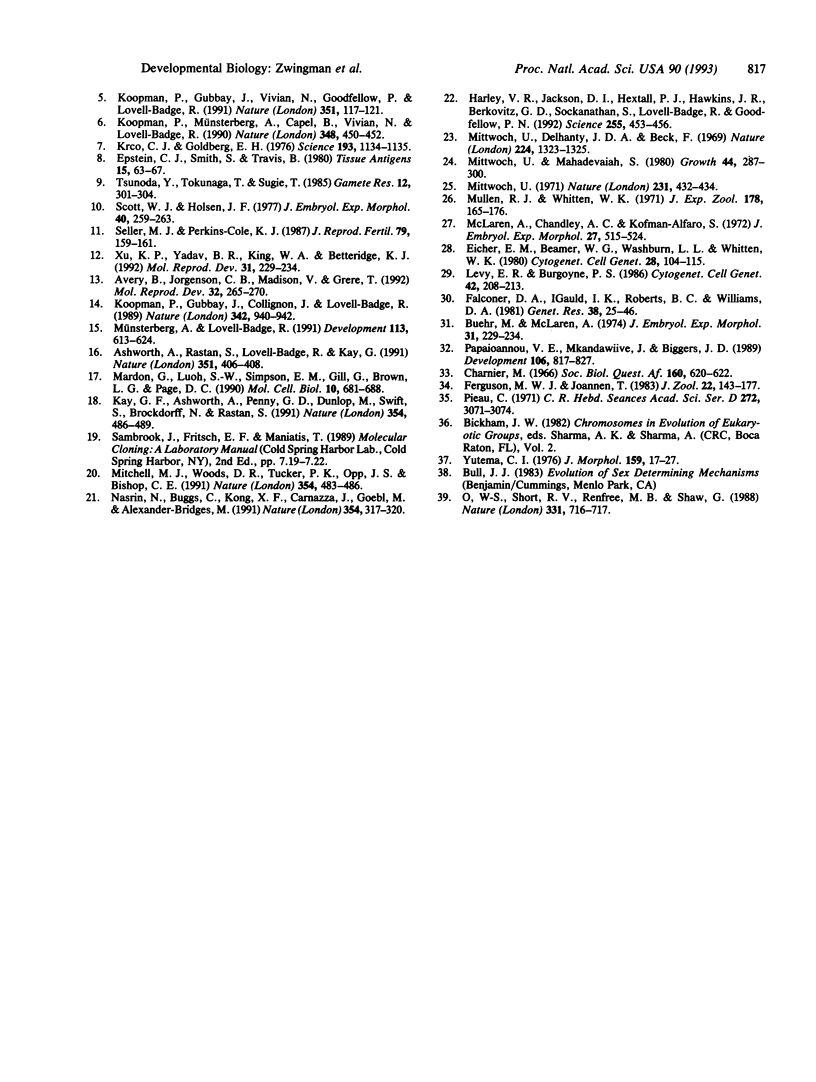Abstract
We have confirmed the faster growth of male preimplantation mouse embryos. We have also studied the transcription of Y chromosomal genes postulated to have a role in sex determination, using the highly sensitive technique of reverse-transcription polymerase chain reaction at these early stages. We find that two sex-determining region genes, Sry and Zfy, are transcribed during mouse preimplantation development, while the Zfy homologs Zfx and Zfa and a sex-determining region gene originally called A1s9 (now called Ube1y-1) are not. We also show that the anti-Müllerian hormone gene, which contains a Sry consensus binding element in its 5' promoter region, is not transcribed at this time. Developmental curves show that Sry and Zfy are expressed commencing at the two-cell stage. These results suggest that mammalian sex determination starts prior to gonad differentiation.
Full text
PDF



Images in this article
Selected References
These references are in PubMed. This may not be the complete list of references from this article.
- Ashworth A., Rastan S., Lovell-Badge R., Kay G. X-chromosome inactivation may explain the difference in viability of XO humans and mice. Nature. 1991 May 30;351(6325):406–408. doi: 10.1038/351406a0. [DOI] [PubMed] [Google Scholar]
- Avery B., Jørgensen C. B., Madison V., Greve T. Morphological development and sex of bovine in vitro-fertilized embryos. Mol Reprod Dev. 1992 Jul;32(3):265–270. doi: 10.1002/mrd.1080320312. [DOI] [PubMed] [Google Scholar]
- Berta P., Hawkins J. R., Sinclair A. H., Taylor A., Griffiths B. L., Goodfellow P. N., Fellous M. Genetic evidence equating SRY and the testis-determining factor. Nature. 1990 Nov 29;348(6300):448–450. doi: 10.1038/348448A0. [DOI] [PubMed] [Google Scholar]
- Buehr M., McLaren A. Size regulation in chimaeric mouse embryos. J Embryol Exp Morphol. 1974 Jan;31(1):229–234. [PubMed] [Google Scholar]
- Charnier M. Action de la température sur la sex-ratio chez l'embryon d'Agama agama (Agamidae, Lacertilien) C R Seances Soc Biol Fil. 1966;160(3):620–622. [PubMed] [Google Scholar]
- Eicher E. M., Beamer W. G., Washburn L. L., Whitten W. K. A cytogenetic investigation of inherited true hermaphroditism in BALB/cWt mice. Cytogenet Cell Genet. 1980;28(1-2):104–115. doi: 10.1159/000131518. [DOI] [PubMed] [Google Scholar]
- Epstein C. J., Smith S., Travis B. Expression of H-Y antigen on preimplantation mouse embryos. Tissue Antigens. 1980 Jan;15(1):63–67. doi: 10.1111/j.1399-0039.1980.tb00886.x. [DOI] [PubMed] [Google Scholar]
- Falconer D. S., Gauld I. K., Roberts R. C., Williams D. A. The control of body size in mouse chimaeras. Genet Res. 1981 Aug;38(1):25–46. doi: 10.1017/s0016672300020383. [DOI] [PubMed] [Google Scholar]
- Gubbay J., Collignon J., Koopman P., Capel B., Economou A., Münsterberg A., Vivian N., Goodfellow P., Lovell-Badge R. A gene mapping to the sex-determining region of the mouse Y chromosome is a member of a novel family of embryonically expressed genes. Nature. 1990 Jul 19;346(6281):245–250. doi: 10.1038/346245a0. [DOI] [PubMed] [Google Scholar]
- Harley V. R., Jackson D. I., Hextall P. J., Hawkins J. R., Berkovitz G. D., Sockanathan S., Lovell-Badge R., Goodfellow P. N. DNA binding activity of recombinant SRY from normal males and XY females. Science. 1992 Jan 24;255(5043):453–456. doi: 10.1126/science.1734522. [DOI] [PubMed] [Google Scholar]
- Kay G. F., Ashworth A., Penny G. D., Dunlop M., Swift S., Brockdorff N., Rastan S. A candidate spermatogenesis gene on the mouse Y chromosome is homologous to ubiquitin-activating enzyme E1. Nature. 1991 Dec 12;354(6353):486–489. doi: 10.1038/354486a0. [DOI] [PubMed] [Google Scholar]
- Koopman P., Gubbay J., Collignon J., Lovell-Badge R. Zfy gene expression patterns are not compatible with a primary role in mouse sex determination. Nature. 1989 Dec 21;342(6252):940–942. doi: 10.1038/342940a0. [DOI] [PubMed] [Google Scholar]
- Koopman P., Gubbay J., Vivian N., Goodfellow P., Lovell-Badge R. Male development of chromosomally female mice transgenic for Sry. Nature. 1991 May 9;351(6322):117–121. doi: 10.1038/351117a0. [DOI] [PubMed] [Google Scholar]
- Koopman P., Münsterberg A., Capel B., Vivian N., Lovell-Badge R. Expression of a candidate sex-determining gene during mouse testis differentiation. Nature. 1990 Nov 29;348(6300):450–452. doi: 10.1038/348450a0. [DOI] [PubMed] [Google Scholar]
- Krco C. J., Goldberg E. H. H-Y male antigen: detection on eight-cell mouse embryos. Science. 1976 Sep 17;193(4258):1134–1135. doi: 10.1126/science.959826. [DOI] [PubMed] [Google Scholar]
- Levy E. R., Burgoyne P. S. The fate of XO germ cells in the testes of XO/XY and XO/XY/XYY mouse mosaics: evidence for a spermatogenesis gene on the mouse Y chromosome. Cytogenet Cell Genet. 1986;42(4):208–213. doi: 10.1159/000132280. [DOI] [PubMed] [Google Scholar]
- Lovell-Badge R., Robertson E. XY female mice resulting from a heritable mutation in the primary testis-determining gene, Tdy. Development. 1990 Jul;109(3):635–646. doi: 10.1242/dev.109.3.635. [DOI] [PubMed] [Google Scholar]
- Mardon G., Luoh S. W., Simpson E. M., Gill G., Brown L. G., Page D. C. Mouse Zfx protein is similar to Zfy-2: each contains an acidic activating domain and 13 zinc fingers. Mol Cell Biol. 1990 Feb;10(2):681–688. doi: 10.1128/mcb.10.2.681. [DOI] [PMC free article] [PubMed] [Google Scholar]
- McLaren A., Chandley A. C., Kofman-Alfaro S. A study of meiotic germ cells in the gonads of foetal mouse chimaeras. J Embryol Exp Morphol. 1972 Jun;27(3):515–524. [PubMed] [Google Scholar]
- Mitchell M. J., Woods D. R., Tucker P. K., Opp J. S., Bishop C. E. Homology of a candidate spermatogenic gene from the mouse Y chromosome to the ubiquitin-activating enzyme E1. Nature. 1991 Dec 12;354(6353):483–486. doi: 10.1038/354483a0. [DOI] [PubMed] [Google Scholar]
- Mittwoch U., Delhanty J. D., Beck F. Growth of differentiating testes and ovaries. Nature. 1969 Dec 27;224(5226):1323–1325. doi: 10.1038/2241323a0. [DOI] [PubMed] [Google Scholar]
- Mittwoch U., Mahadevaiah S. Additional growth--a link between mammalian testes, avian ovaries, gonadal asymmetry in hermaphrodites and the expression of H-Y antigen. Growth. 1980 Dec;44(4):287–300. [PubMed] [Google Scholar]
- Mittwoch U. Sex determination in birds and mammals. Nature. 1971 Jun 18;231(5303):432–434. doi: 10.1038/231432a0. [DOI] [PubMed] [Google Scholar]
- Mullen R. J., Whitten W. K. Relationship of genotype and degree of chimerism in coat color to sex ratios and gametogenesis in chimeric mice. J Exp Zool. 1971 Oct;178(2):165–176. doi: 10.1002/jez.1401780203. [DOI] [PubMed] [Google Scholar]
- Münsterberg A., Lovell-Badge R. Expression of the mouse anti-müllerian hormone gene suggests a role in both male and female sexual differentiation. Development. 1991 Oct;113(2):613–624. doi: 10.1242/dev.113.2.613. [DOI] [PubMed] [Google Scholar]
- Nasrin N., Buggs C., Kong X. F., Carnazza J., Goebl M., Alexander-Bridges M. DNA-binding properties of the product of the testis-determining gene and a related protein. Nature. 1991 Nov 28;354(6351):317–320. doi: 10.1038/354317a0. [DOI] [PubMed] [Google Scholar]
- O W. S., Short R. V., Renfree M. B., Shaw G. Primary genetic control of somatic sexual differentiation in a mammal. Nature. 1988 Feb 25;331(6158):716–717. doi: 10.1038/331716a0. [DOI] [PubMed] [Google Scholar]
- Papaioannou V. E., Mkandawire J., Biggers J. D. Development and phenotypic variability of genetically identical half mouse embryos. Development. 1989 Aug;106(4):817–827. doi: 10.1242/dev.106.4.817. [DOI] [PubMed] [Google Scholar]
- Pieau C. Sur la proportion sexuelle chez les embryons de deux chéloniens (Testudo graeca L. et Emys orbiculairs L.) issus d'oeufs incubés artificiellement. C R Acad Sci Hebd Seances Acad Sci D. 1971 Jun 14;272(24):3071–3074. [PubMed] [Google Scholar]
- Scott W. J., Holson J. F. Weight differences in rat embryos prior to sexual differentiation. J Embryol Exp Morphol. 1977 Aug;40:259–263. [PubMed] [Google Scholar]
- Seller M. J., Perkins-Cole K. J. Sex difference in mouse embryonic development at neurulation. J Reprod Fertil. 1987 Jan;79(1):159–161. doi: 10.1530/jrf.0.0790159. [DOI] [PubMed] [Google Scholar]
- Sinclair A. H., Berta P., Palmer M. S., Hawkins J. R., Griffiths B. L., Smith M. J., Foster J. W., Frischauf A. M., Lovell-Badge R., Goodfellow P. N. A gene from the human sex-determining region encodes a protein with homology to a conserved DNA-binding motif. Nature. 1990 Jul 19;346(6281):240–244. doi: 10.1038/346240a0. [DOI] [PubMed] [Google Scholar]




